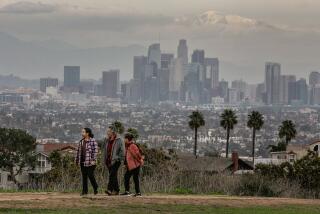Mother Nature pulls a fast one on forecasters
- Share via
For a region often ridiculed for the sameness of its weather, Los Angeles can point to 2010 as proof that it, too, deals with the extremes of Mother Nature.
It was substantially cooler than average this spring and summer. Then in late September, Los Angeles registered its hottest day ever recorded. Now, Southern California is in the throes of a rainstorm that could result in its wettest December on record.
The sharp changes have even veteran forecasters scratching their heads and searching for answers. Many forecasters had predicted the region would have a dryer than normal winter.
“Just when you think you have Mother Nature figured out, she sticks a finger in your eye,” said Bill Patzert, a climatologist for the Jet Propulsion Laboratory.
There are no easy answers for the strange weather this year, scientists say. In general, as the globe warms, weather conditions tend to be more extreme and volatile, Patzert said.
More than 5 inches of rain have already fallen in downtown Los Angeles this month, and the record of 8.77 inches for December is within reach. Mammoth Mountain has already recorded the highest December snow levels ever.
After four days of pounding rain, another major storm is expected to hit Los Angeles on Tuesday and last through Wednesday night. Then another storm is expected to settle in over the Christmas weekend.
Until now, Patzert and other forecasters had been predicting a La Niña winter, defined by cooler than normal temperatures in the Pacific and lower than average rainfall in Southern California. Jamie Meier, a meteorologist for the National Weather Service in Oxnard, said it’s too early to assume that the region’s traditionally wettest months, January, February and March, will be similarly rainy. But with this month’s storms, Los Angeles’ rainfall is already well above average.
Meier noted that this year has also been marked by a lack of hot, dry Santa Ana winds. That, combined with several fall storms, has resulted in a conspicuous lack of major brush fires that often occur in October and November.
“We get a bad rap when it comes to having boring weather,” Meier said. “But we’ve had quite a varied season, from record-breaking heat to getting a heavily frontloaded rainfall year.”
Monday marked the fifth day of heavy rains and snow across California. Kern County was among the hardest-hit areas, and officials declared a state of emergency. Authorities evacuated 2,000 residents from the small farming town of McFarland as floodwaters threatened homes.
“About 400 to 500 houses are in danger of flooding around there,” said spokesman Sean Collins of the Kern County Fire Department. “What we have there is quite a lot of farmland with ditches and drainages and canals. Without knowing, 100% it is quite possible one of the ditches either ran over or one of the banks broke.”
Downtown Los Angeles has received more than 5 inches of rain since storms moved into the area Thursday. The foothill communities, including those near the Station fire burn area, have received as much as 9 inches of rain, Patzert said.
So far, there have been no major mudsides or flooding reported in areas burned in 2009’s Station fire. But residents and authorities are bracing for heavy rain expected later this week.
Numerous roads were closed at times because of flooding and slides, including Pacific Coast Highway through Malibu, the 710 Freeway in Long Beach and Coast Highway in Dana Point.
A northern cold front is expected to move into the Los Angeles Basin early Tuesday, colliding with subtropical moisture that has been sitting off the Pacific coast for several days. Periods of intense rainfall through Wednesday will bring an additional 5 inches to coastal plains and valleys and up to 10 inches in the mountains, Meier said.
Despite the heavy rain, rivers are not expected to flood. Ground saturation is climbing, but it is still far below the 15 inches or so that would trigger major mudslides, Meier said.
“We’ve had a relatively dry five years,” she said. “The majority of debris flows we’ve seen in the past few years have been the result of isolated thunderstorm activity.”
She cautioned that burn areas, such as La Cañada Flintridge and Tujunga, will need to keep a closer eye on flooding because the ground is unable to hold as much water as other areas. Neighborhoods have been sandbagging threatened streets and homes for days.
The cold front sweeping down from Washington state is expected to cause temperatures to fall a few degrees and bring snow levels from 9,000 feet to 6,000 feet. Forecasters say the Grapevine on Interstate 5 should not experience any flurries as a result of Monday’s storm.
“It’s pretty unusual to get a storm of this duration in December,” Patzert said. “But it’s been that kind of year.”
Indeed, 2010 is destined to be remembered as the year of the “unusual.”
Summer was marked by gloomy, cool conditions. It drizzled in July, and didn’t heat up that much in August. Patzert said that the summer was about 2 degrees cooler than normal. But the daytime high temperatures were 3 to 4 degrees cooler than average.
Then, just as people got used to one of the coolest summers in years, came Sept. 27. On that day, downtown Los Angeles reached 113 degrees — a record high. It got so hot that the National Weather Service’s thermometer at USC actually broke.
Two weeks ago, temperatures in the mid- to high 80 set records in some areas.
Those toasty dry conditions are just a memory now. And Patzert said that when it comes to rain, the worst is yet to come.
“What we’ve seen so far is the preliminary event. Tuesday and Wednesday is the main event,” he said. “I think we’re going to crush the record for December. I think there’s going to be a new champ.”
catherine.saillant@latimes.com
Times staff writers Shan Li and Rong-Gong Lin II contributed to this report.
More to Read
Sign up for Essential California
The most important California stories and recommendations in your inbox every morning.
You may occasionally receive promotional content from the Los Angeles Times.















